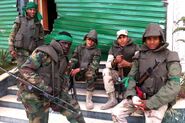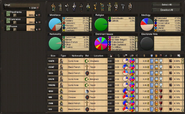
The Libyan Arab Jamahiriya (2 March 1977-20 October 2011) was an Islamic socialist and Arab nationalist direct democracy located in North Africa. Led by Supreme Guide Muammar Gaddafi for all 34 years of its existence, it succeeded the Libyan Arab Republic of 1969-1977, also led entirely by Gaddafi. The nation was an authoritarian regime, lasting for several decades with Soviet Union support, as it was an enemy of the United States during the Cold War. It was also known to support terrorist groups such as the Irish Republican Army and the Palestine Liberation Organization. In 2011, Gaddafi was ousted in the Libyan Revolution, during which he was killed and the country transformed into a democracy.
History[]

The location of Libya
Muammar Gaddafi seized power in Libya in a military coup in 1969, overthrowing the Kingdom of Libya and founding the Libyan Arab Republic. This new country was ruled for all eight years of its existence by Gaddafi, who began to remake Libyan culture in 1973. In 1977, he disbanded the ruling Revolutionary Command Council and replaced it with the General People's Congres, and replaced the republic with the "Libyan Arab Jamahiriya", an authoritarian regime with Arab nationalist and Islamic socialist ideas.

Gaddafi was an Arabized Berber, and during his authoritarian rule, he made it illegal to teach the Berber language or to have Berber names, forcing the Arabization of several tribal Berbers across the country. He also forced many black Africans to be assimilated into Arab culture, and Libya's conversion of its denizens into an Arab cultural society was a large achievement of the regime. In addition, Gaddafi had a cult of personality, having posters advertising his greatness and celebrating his many years of rule. When his son Saadi Gaddafi was a soccer player, Gaddafi allowed only Saadi's name to be announced during games, with the other players being referred to merely by their numbers.
The Libyan Arab Jamahiriya was supported by the Soviet Union due to its socialist views, and it became an enemy of the United States due to its support of terrorism. Libya gave cash and weapons to the Irish Republican Army (IRA) and Palestine Liberation Organization (PLO) terrorist groups, among others, and were responsible for the bombing of a nightclub in West Berlin in 1986 that killed several American servicemen. The United States president Ronald Reagan responded with Operation Eldorado Canyon, bombing Libya and killing one of Gaddafi's daughters in addition to many soldiers and civilians. Throughout the 1980s, there were also aerial clashes over the Gulf of Sidra, which Gaddafi claimed was Libya's possession. However, American planes enforced its availability to international vessels by shooting down several Libyan planes and fighting their forces. Gaddafi avenged these setbacks with the Lockerbie bombing, blowing up Pan Am Flight 103 and killing many on the ground at Lockerbie, Scotland when the plane rained burning fuel on the townspeople. Only later did Gaddafi distance himself from terrorism, and in the 1990s and 2000s he paid reparations to the victims of Libyan terrorist attacks.
During the 1980s, Gaddafi engaged in several battles with neighboring Chad to the south to expand Libya. Taking advantage of the Chadian Civil War, Gaddafi made progress, but in the 1987 Battle of Fada, the Chadians destroyed his forces and counterattacked, forcing Gaddafi to stop his plans of attacking Chad. Libya's power was broken, although the people were still brainwashed by Gaddafi's propaganda. Disenchanted Libyans were thrown in prisons in secret locations, and the Libyan Islamic Fighting Group (LIFG), an al-Qaeda-funded terrorist/resistance organization, rose up several times in attempts to oust Gaddafi. Every time, Gaddafi's forces quelled the uprisings, which were not supported by the United States - the USA was more hostile towards the terrorists (who later committed the 9/11 attacks on 11 September 2001) than Gaddafi.
Gaddafi's rule was brought to a bloody end in 2011 in the Libyan Revolution. Initially large protests influenced by the Tunisian Revolution on the western border and the other Arab Spring riots were met by assault rifle fire from Gaddafi's soldiers, and many people were killed by his regime in peaceful protests. Eventually, the protesters became armed rebels and seized Benghazi, and despite many reverses early in the year, on 19 March they received the support of the United Nations and NATO, who set up a no-fly zone. NATO planes bombed Gaddafi's forces to assist the rebel National Transitional Council, and in October 2011 the last stronghold of Sirte fell. Gaddafi and his son Mutassim Gaddafi were both killed, and the country became a democracy under the NTC.




